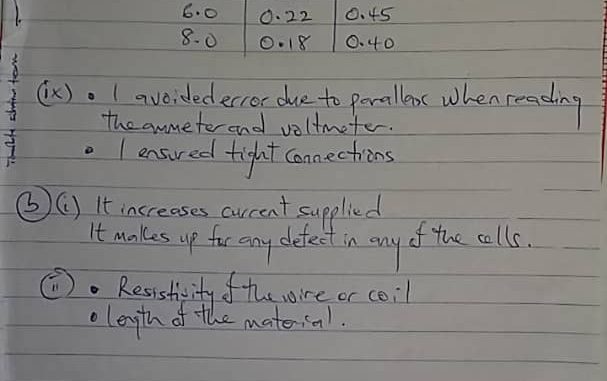
Physics expo
| Is physics answers ready | how do i get physics answers | Physics practical expo | How to get physics questions | waec runs 2023 | legit physics runs
PHYSICS OBJ
1-10: CBAACCAABD
11-20: DBDDCDAAAD
21-30: BDCDADDCCB
31-40: CBBABACBBC
41-50: ADDACCCCCD
2b
The expression for the energy stored, E, in a stretched wire can be given by:
E = (1/2) * Y * A * e^2
Where:
– E represents the energy stored in the wire.
– Y is the Young’s modulus of the material, which measures its stiffness.
– A is the cross-sectional area of the wire.
– e is the extension or change in length of the wire from its original length.
The energy stored in the wire is proportional to the square of the extension and is directly influenced by the Young’s modulus and cross-sectional area.
(4)
(PICK ANY THREE)
(i) Geostationary satellites orbit the Earth directly above the equator in a geosynchronous orbit. They remain fixed relative to a specific point on the Earth’s surface WHILE Polar satellites orbit the Earth in a polar orbit, passing over or near the North and South poles on each orbit.
(ii) Geostationary satellites have an inclination of 0 degrees, meaning their orbital plane aligns with the equatorial plane WHILE Polar satellites have a high inclination angle (usually around 90 degrees) to achieve polar orbits.
(iii) Geostationary satellites provide coverage over a large portion of the Earth’s surface (typically one-third to half) but are limited to a specific longitude range WHILE Polar satellites provide global coverage, as they pass over or near the poles on each orbit, covering the entire Earth’s surface over time.
(iv) Geostationary satellites observe the Earth from a fixed position, providing a continuous view of a specific region WHILE Polar satellites observe the Earth from a changing perspective as they orbit, resulting in different views of the Earth’s surface with each pass.
(v) Geostationary satellites primarily collect data for meteorological observations, weather forecasting, and telecommunications WHILE Polar satellites collect data for a wide range of applications, including weather monitoring, climate research, environmental monitoring, and scientific research.
(vi) Geostationary satellites are positioned at an altitude of approximately 35,786 kilometers (22,236 miles) above the Earth’s surface WHILE Polar satellites generally operate at lower altitudes, typically between 700 and 1,500 kilometers (435 to 932 miles.
(vii) Geostationary satellites provide a continuous stream of data and observations for a specific region, allowing for real-time monitoring WHILE Polar satellites have a lower data refresh rate since they pass over a given area less frequently. However, they provide a broader coverage over time.
7(a) Fibre optics is a technology that uses thin, flexible fibres made of glass or plastic to transmit data in the form of light signals over long distances.
7(b) :
– Higher bandwidth: Optical fibres can carry more data over longer distances than copper cables without degradation of the signal. This makes them ideal for high-speed internet connections, video streaming, and other data-intensive applications.
– Immunity to electromagnetic interference: Unlike copper cables, optical fibres are not affected by electromagnetic interference from other devices or sources. This makes them more reliable and less prone to signal loss or distortion.
5b)
Wave: Diffraction of light through a narrow slit or around an obstacle is a phenomenon that demonstrates that light behaves as a wave. This is because the diffraction pattern of light shows interference fringes, which are characteristic of wave interference.
Particle: The photoelectric effect is a phenomenon that demonstrates that light behaves as a particle. This is because the photoelectric effect involves the emission of electrons from a metal surface when it is illuminated by light. The energy of the emitted electrons is proportional to the frequency of the light, which is consistent with the idea that light is made up of particles, or photons, with discrete energy levels.

Leave a Reply